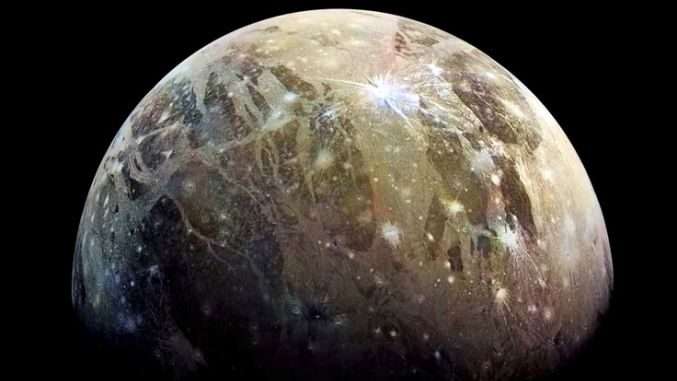
Ganymede is the biggest satellite in the solar system, and also the biggest object in the solar system that does not have a substantial atmosphere. Discovered by Galileo in January of the year 1610 along with Io, Callisto and Europa, it was the motion of these bodies around Jupiter that led to the realization that everything in the solar system was orbiting the Sun, and that Earth was therefore not the center of the Universe. Below are some more interesting facts about Ganymede.
Ganymede is named after a Trojan prince
Ganymede was originally named Jupiter III by its discoverer, but this was changed to Ganymede, after a suggestion made by Johannes Kepler, a famous German astronomer and mathematician. In Greek mythology, Ganymede was a prince in the city-state of Troy who had the misfortune to be kidnapped by Zeus to become a cupbearer to the gods who lived on Mount Olympus.
Ganymede should be a planet, but isn’t
Ganymede is the largest satellite in the solar system, bigger than both the planets Mercury and Pluto, and two-thirds the size of Mars. It is also more than twice as massive as our moon, making it the most massive of all planetary moons in the solar system. Based on its mass and diameter of 5,269 km, it should have been a planet, but since it orbits a planet and not the Sun, it is classified as a moon.
Ganymede has an orbital period of 7.1 days
Like most moons in the solar system, Ganymede is tidally locked to Jupiter, which means it keep the same face turned toward Jupiter during its orbit that takes 7.1 days to complete, moving at a speed of 39,165 km/h. Ganymede also completes one orbit in the same time it takes Europa to orbit Jupiter twice, and the moon Io to orbit Jupiter four times.
Ganymede has its own magnetic field
Ganymede is the only known solar system satellite that has its own magnetosphere, and although it is very weak and barely detectable, it is thought to have been created by convection currents in the molten iron core of the moon. Detailed studies of the moon’s magnetosphere are made very difficult on account of the fact that much of it is drowned out by Jupiter’s much stronger magnetosphere.
Ganymede may have a buried ocean
As with many other solar system moons, most investigators are of the opinion that Ganymede may have an ocean of liquid saltwater buried deep beneath its rocky surface. In fact, recent studies suggest that this ocean may consist of several layers of saltwater, which are separated by thick layers of ice in different phases, and that the deepest liquid layer may directly overlay the moon’s rocky mantle.
Ganymede has an atmosphere
Although the moon is massive enough to retain an atmosphere, the atmosphere is exceedingly tenuous, and while it does contain oxygen, the oxygen content is too low to sustain life as we currently understand it.
Ganymede is made of rock and ice
The moon consists of rock and mainly water ice, in roughly equal proportion. Unlike Jupiter’s moon Callisto, Ganymede is fully differentiated and consists of a liquid, iron-rich core, a relatively thick mantle, a deep liquid ocean that likely contains more water than all of Earth’s oceans combined, and a thick icy crust.
Ganymede may have formed through accretion
Like Callisto, Ganymede is thought to have formed by a process of accretion from the gas and dust that was left over after Jupiter’s formation. However, since Ganymede formed closer to Jupiter than Callisto, the residual gas and dust was denser, which means that Ganymede likely formed within about 10,000 years, as opposed to the 100,000 years or so Callisto took to form. In the case of Ganymede, its shorter accretion time and denser material prevented accretion heat from escaping, meaning that ice melt and differentiation into distinct layers was made possible.
Ganymede has polar ice caps
Ganymede is known to have polar ice caps that likely consist of water ice. The polar caps extend to latitude 40 degrees, and while there have been many theories about their origin, data from the Voyager spacecraft suggest that the ice caps form due to the action of plasma bombardment through the moon’s magnetic field that forces water molecules to migrate to higher latitudes, where the water turns to frost in colder areas within the polar regions.
Ganymede was once tectonically active
The 60% or so of Ganymede’s surface that consists of material that is lighter in color than the remaining 40% is thought to be the result of the effects of tidal heating that has tectonically recycled some of the surface material. In practice, this means that about 60% of the moon’s surface is younger than the rest of the surface, which is clear from the fact that the older, darker parts of the surface is more heavily cratered than the lighter-colored parts.
